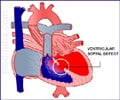A way to simulate blood flow on the computer to optimize surgical designs has been developed by a team of researchers at the University of California, San Diego and Stanford University.
A way to simulate blood flow on the computer to optimize surgical designs has been developed by a team of researchers at the University of California, San Diego and Stanford University.
It is the basis of a new tool that may help surgeons plan for a life-saving operation called the "Fontan" surgery, which is performed on babies born with severe congenital heart defects.The researchers will present their work next week at the 62nd Annual Meeting of the American Physical Society's (APS) Division of Fluid Dynamics will take place from November 22-24 at the Minneapolis Convention Center.
Babies who get this surgery have a developmental disease where one of the chambers -- or ventricles -- of the heart fails to grow properly. This leaves their hearts unable to properly circulate blood through their lungs and starves their bodies of oxygen. The lack of oxygen turns their skin blue, a condition sometimes referred to as "blue baby syndrome" for that reason.
The Fontan surgery is one of three surgeries performed immediately after birth to replumb the circulation of children born missing their left ventricles. The operation essentially connects the veins that would normally bring blood into the right side of the heart with the pulmonary arteries. The aim is to redirect the blood flow so that it becomes properly oxygenated, allowing the patient to survive with only one functional pumping chamber. Before the advent of this type of surgery in the early 1970's, these sorts of heart conditions were uniformly fatal.
There are still risks, including exercise intolerance, blood clot formation, and eventual heart failure requiring transplantation. Doctors mitigate this risk by carefully planning the surgery, starting with images of a baby's heart and then sketching out their plans. UCSD's Alison Marsden has been working with surgeons at Rady Children's Hospital and Stanford University to develop a new computational tool to assist in this process. In addition, Dr. Marsden and cardiologist Jeff Feinstein have developed a new Y-graft design for the Fontan surgery that is expected to be put into clinical use within a few months.
"Our ultimate goal is to optimize surgeries that are tailored for individual patients so that we don't have to rely on a "one-size fits all" solution," says Marsden.
Advertisement
The talk " Analysis of Alternative Polling Strategies for Derivative-Free Optimization of the Fontan Surgery" by Weiguang Yang, Jeffrey Feinstein, and Alison Marsden is at 12:06 p.m. on Tuesday, November 24, 2009.
Advertisement
Source-Eurekalert
RAS















